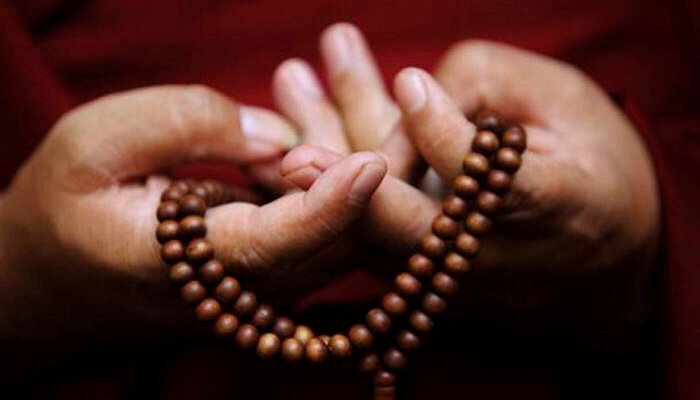Mala Japa Meditation
A Meditation ritual for Presence
Photo from Monkmala.com
How to do it:
Find a comfortable yet well-aligned position for meditation.
Traditionally meditation is practiced seated on the floor. Cushions or folded blankets can be used under the sitting bones to keep the back comfortable. If seated in a chair have the feet flat on the floor and keep the spine straight–do not lean into the back of the chair if possible. Root down through the legs as you lift up through the crown of the head. Keep the shoulders relaxed and the heart open and lifted. The most common seated poses for meditation are Easy Pose, Accomplished Pose, Hero Pose, and Half Lotus Pose.
During japa meditation, the eyes can be open with a soft gaze or the eyes can be gently closed.
This helps bring your attention and awareness inwards. Try to minimize all external distractions. A quiet, dimly lit room will be best to meditate in.
The breath should be slow, deep and relaxed. Breathe slowly in and out through your nose.
Use diaphragmatic breathing during meditation–feel your belly expand outwards with each inhalation and contract with the exhalation.
Hold your mala in your right hand and use your thumb and middle finger to “count” each mantra by touching the gemstone or seed during the recitation of the chant.
On each recitation lightly pull the bead towards you with your fingers as you complete the mantra to moving to the next bead. The index finger is extended away from the hand and should not touch the prayer beads or be used for counting. The large meru (mountain) or guru (teacher) bead should not be counted or touched by the thumb. The guru is used as the marker for the starting and ending point of the recitation.
Continue by pulling the beads with your fingers for each mantra until you end at the meru or guru and have completed 108 repetitions.
(If you have a bracelet of 27 beads you will need to repeat this 3 more times.)
You can continue with the practice chanting repetitions of 108 mantras.
Keep your mind focused on the mantra and centered on the feeling of the thumb touching the mala bead. When thoughts arise shift your attention back to the chant and the mala. Experiment with the tempo of the mantra recitation to find the pace that is most able to focus your attention.
Some yogic and Buddhist traditions synchronize the breath with the chanting to further focus the mind. For the breathing meditation, you will hold and use your prayer beads the same way as you do for the japa meditation technique.
For this breathing meditation, repeat these four distinct steps:
1. Take a slow, deep breath in through your nose, directing the breath into your low belly.
2. Pause for 1-2 seconds.
3. Slowly exhale the breath out through the nose.
4. Pause for 1-2 seconds. For each round, either count each breath with each bead on the mala, or use one bead to count each of the four steps of the breath. Focus your mind on the sensation of each of these four steps of your breath as you touch each bead with your fingers. Whenever thoughts or distractions arise in your mind, turn your focus back to the feelings of your breathing and the touching of each gemstone or seed.
Why do it:
There are many benefits to including a mala into your meditations and rituals.
It increases focus during mantra meditation, as it is an efficient and practical tool to count mantras, and an easy way to keep track of the number of mantras recited.
Physical contact with prayer beads transmits their inherent healing powers.
Once mala is empowered it can be used for even more powerful healing of yourself and others.
Choosing a mala to purchase can help in process of determining goals and intentions and spiritual pursuits.
Seeing or wearing a mala can serve as a reminder of one’s intention and goals.
It can also be used as a reward or symbol for accomplishing a difficult task.
When to do it:
Variable
How long it takes:
Varies
Materials needed:
Mala beads

